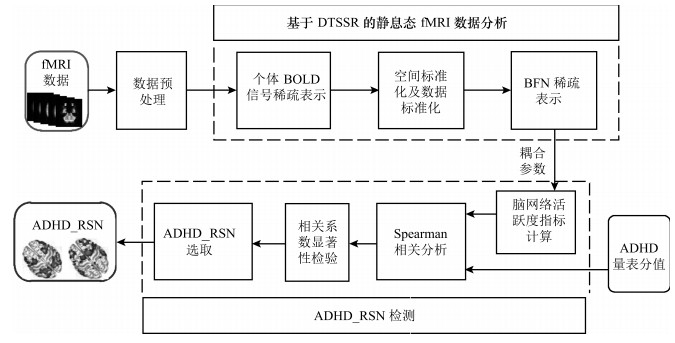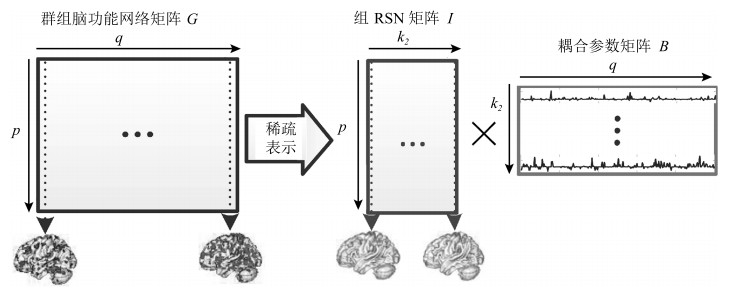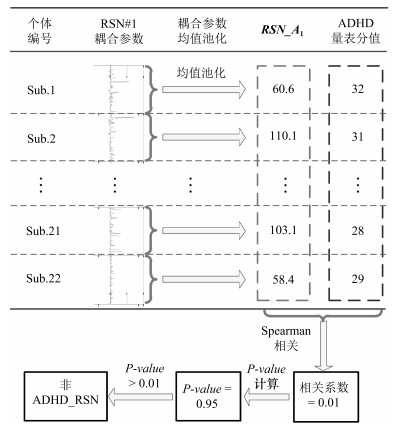Detecting and Analyzing Brain Networks of Adult ADHD Using Dual Temporal and Spatial Sparse Representation
-
摘要: 注意力缺陷多动障碍(Attention deficit hyperactivity disorder,ADHD)主要表现为注意力分散、多动和冲动,是一种常见的精神障碍疾病.作为一种流行的脑功能成像技术,静息态功能核磁共振成像(Resting-state functional magnetic resonance imaging,rsfMRI)常应用于探索ADHD的神经机制.然而,由于rsfMRI数据的高维和少样本特性,采用传统的独立成分分析方法从rsfMRI数据中获得脑网络后,大多用基于体素级的方法进行推断,这难以检测出可靠的、与ADHD相关的脑网络.针对上述问题,本文提出了一种新颖的基于时空双稀疏表示(Dual temporal and spatial sparse representation,DTSSR)的方法和指标,以22名成人ADHD患者为研究对象,从大尺度脑网络级的角度检测出与ADHD相关的脑网络.首先采用DTSSR从ADHD的rsfMRI数据中提取出组脑网络及相应的耦合参数;然后将耦合参数均值池化作为网络的活跃度指标;最后,将活跃度指标与ADHD的量表分进行Spearman相关性分析,检测出与ADHD相关的脑网络.实验结果表明,背侧注意网络、执行控制网络的活跃度与ADHD量表分具有显著相关性.该结果在脑科学角度有合理的解释,且在不同字典尺寸下具有较高稳定性.本文所提方法,为探讨ADHD的潜在神经机制提供了一种新思路.Abstract: Attention deficit hyperactivity disorder (ADHD) is a highly prevalent psychiatric disorder, which is generally characterized by symptoms of inattentiveness, hyperactivity and impulsivity. As a popular functional imaging technique, the resting-state functional magnetic resonance imaging (rsfMRI) is frequently used to explore the neural mechanism of ADHD. However, after resting-state brain networks are obtained from the rsfMRI dataset with the traditional independent component analysis, it is difficult to detect reliable ADHD-related brain networks via voxel-level inference because of the high dimensions and relatively few samples of fMRI data. To address the problem, a novel framework and index using the dual temporal and spatial sparse representation (DTSSR) is proposed, which is able to detect the resting-state brain networks related to ADHD from a large scale network-level perspective in an rsfMRI dataset consisting of 22 adult ADHD patients. First, the group-wise brain networks and coupling parameters are inferred from the ADHD fMRI dataset via DTSSR. These coupling parameters are then processed by average-pooling as an index for activity of each group-wise network. Finally, the Spearman correlation analysis between those obtained indices and the ADHD rating scores is performed to detect the networks related to ADHD. Experiment demonstrates that the dorsal attention network and executive control network are significantly related to ADHD. The result shows high stability under different dictionary sizes and can be reasonably explained from brain science. The proposed framework can be used to explore the underlying neural mechanism of ADHD in a new perspective.1) 本文责任编委 朱朝喆
-
表 1 表 1 ADHD组人口统计学特性
Table 1 Demographic of the ADHD group
患者人数 性别比(男:女) 年龄 ADHD分值 22 17:5 34.6±9.4 30.8±8.6 表 2 ADHD组量表分、脑网络活跃程度指标、相关系数、$P$-$value$及ADHD_RSN检测结果
Table 2 The obtained ADHD_RSN, indexes for activity of brain networks, correlation\\ coefficients, $P$-$value$ and ADHD_RSN
患者 量表 RSN RSN RSN RSN RSN RSN RSN RSN RSN RSN RSN RSN RSN RSN RSN RSN RSN RSN RSN RSN 编号 分 #1 #2 #3 #4 #5 #6 #7 #8 #9 #10 #11 #12 #13 #14 #15 #16 #17 #18 #19 #20 Sub. 1 32 61 74 96 75 83 96 90 94 52 73 101 78 72 104 90 111 58 68 54 92 Sub. 2 31 110 80 70 74 90 107 77 130 56 68 100 70 117 91 80 134 53 70 59 53 Sub. 3 48 88 85 89 58 97 87 87 92 54 55 125 80 78 80 83 123 38 80 58 68 Sub. 4 35 94 100 102 70 113 122 102 133 54 64 93 92 83 85 67 158 54 92 59 92 Sub. 5 21 73 70 74 60 68 84 77 88 65 104 88 75 70 95 66 123 43 68 54 82 Sub. 6 22 81 85 96 77 81 84 75 96 48 59 81 80 71 83 68 158 47 67 51 76 Sub. 7 42 72 72 100 65 94 104 77 108 64 83 106 95 93 91 90 106 37 84 57 88 Sub. 8 37 69 97 106 65 96 101 97 128 77 66 93 90 85 102 105 154 56 70 64 103 Sub. 9 29 88 55 57 49 66 54 64 92 41 67 67 55 62 58 56 139 29 66 43 85 Sub. 10 35 70 101 102 70 80 85 75 111 54 75 109 71 80 89 76 133 44 65 46 85 Sub. 11 41 73 84 61 52 73 92 78 106 85 48 106 65 81 90 65 115 48 61 56 50 Sub. 12 31 89 97 106 74 93 110 86 99 60 60 97 93 71 98 71 140 40 99 56 84 Sub. 13 11 56 67 77 64 87 70 77 71 53 43 73 56 66 89 48 124 37 28 44 49 Sub. 14 44 72 92 91 98 90 109 86 93 62 37 99 110 82 83 77 112 41 66 69 94 Sub. 15 21 87 56 53 50 85 58 55 90 52 67 65 50 70 50 56 116 37 59 39 102 Sub. 16 32 116 81 81 50 106 92 73 115 75 92 92 75 98 83 71 142 45 98 51 90 Sub. 17 23 76 96 81 78 90 102 88 113 67 50 107 106 89 98 83 107 55 70 58 55 Sub. 18 25 82 89 80 49 84 63 74 107 41 75 87 87 97 76 70 143 43 80 35 83 Sub. 19 30 63 53 71 65 61 76 77 66 42 31 81 59 55 69 65 107 46 48 60 61 Sub. 20 31 59 70 121 101 70 118 88 93 59 43 114 87 106 104 100 101 41 38 79 53 Sub. 21 28 103 86 93 79 145 88 86 156 96 71 108 74 71 86 93 146 56 92 59 106 Sub. 22 29 58 64 51 52 58 55 71 92 38 63 54 50 81 55 37 134 30 64 34 65 相关系数 0.01 0.41 0.39 0.12 0.36 0.56 0.40 0.33 0.33 0.06 0.57 0.39 0.44 0.17 0.49 0.14 0.14 0.26 0.47 0.22 $P$-$value$ 0.953 0.059 0.070 0.594 0.100 0.006 0.061 0.129 0.138 0.801 0.005 0.072 0.042 0.450 0.021 0.541 0.540 0.240 0.024 0.333 FDR校正 0.95 0.16 0.16 0.66 0.20 0.06 0.16 0.23 0.23 0.84 0.06 0.16 0.16 0.60 0.12 0.64 0.64 0.37 0.12 0.48 相关网络 × × × × × √ × × × × √ × × × × × × × × × 注: Sub. 1 $\sim$ Sub. 22表示患者编号; "×"表示与ADHD_RSN无关; "√"表示与ADHD_RSN相关. 表 3 不同字典尺寸下与各模板网络空间相关的ADHD_RSN统计
Table 3 The count of the ADHD_RSN with each template in different dictionary sizes
字典尺寸 60 100 140 180 220 260 300 RSN#1 / 1 / / 1 / / RSN#2 / / / / / / / RSN#3 1 2 2 3 / / 1 RSN#4 / / / / / / 1 RSN#5 1 1 3 3 2 3 1 RSN#6 2 2 4 5 3 4 3 RSN#7 1 / 2 3 2 2 4 RSN#8 5 4 7 4 4 6 6 RSN#9 2 5 3 2 6 4 3 RSN#10 / / / / / / / RSN#11 2 1 4 3 3 2 2 RSN#12 / 2 2 1 1 1 / RSN#13 / / / / / / / RSN#14 / / 1 2 / / / RSN#15 / / 1 / 1 2 1 RSN#16 / 2 1 2 / / 1 RSN#17 / / 1 1 1 1 1 RSN#18 / / 1 1 1 / 1 RSN#19 / / / 1 1 1 2 RSN#20 / / / 1 2 1 / 注: "/"表示未检测到与模板网络相关的ADHD_RSN. -
[1] Association A P. Diagnostic and Statistical Manual of Mental Disorders:DSM-IV-TR. Virginia:American Psychiatric Publishing, 2000. 59-66 [2] Fayyad J, De Graaf R, Kessler R, Alonso J, Angermeyer M, Demyttenaere K, et al. Cross-national prevalence and correlates of adult attention-deficit hyperactivity disorder. British Journal of Psychiatry, 2007, 190(5):402-409 doi: 10.1192/bjp.bp.106.034389 [3] 曹庆久, 王晓丽, 曲姗, 王鹏, 吴赵敏, 孙黎, 等.认知行为治疗对成人注意缺陷多动障碍静息态局部脑功能影响.中国心理卫生杂志, 2017, 31(3):183-189 doi: 10.3969/j.issn.1000-6729.2017.03.002Cao Qing-Jiu, Wang Xiao-Li, Qu Shan, Wang Peng, Wu Zhao-Min, Sun Li, et al. Effects of cognitive-behavioral therapy on regional homogeneity changes in adults with attention-deficit/hyperactivity disorder. Chinese Mental Health Journal, 2017, 31(3):183-189 doi: 10.3969/j.issn.1000-6729.2017.03.002 [4] Tian L X, Jiang T Z, Liang M, Zang Y F, He Y, Sui M Q, et al. Enhanced resting-state brain activities in ADHD patients:a fMRI study. Brain and Development, 2008, 30(5):342-348 doi: 10.1016/j.braindev.2007.10.005 [5] Zhu C Z, Zang Y F, Cao Q J, Yan C G, He Y, Jiang T Z, et al. Fisher discriminative analysis of resting-state brain function for attention-deficit/hyperactivity disorder. NeuroImage, 2008, 40(1):110-120 doi: 10.1016/j.neuroimage.2007.11.029 [6] Wang X H, Jiao Y, Tang T Y, Wang H, Lu Z H. Altered regional homogeneity patterns in adults with attention-deficit hyperactivity disorder. European Journal of Radiology, 2013, 82(9):1552-1557 doi: 10.1016/j.ejrad.2013.04.009 [7] Akdeniz G. Complexity analysis of resting-state fMRI in adult patients with attention deficit hyperactivity disorder: brain entropy. Computational Intelligence and Neuroscience, 2017, 2017: Article ID 3091815 [8] Zhao Q H, Li H, Yu X Y, Huang F, Wang Y F, Liu L, et al. Abnormal resting-state functional connectivity of insular subregions and disrupted correlation with working memory in adults with attention deficit/hyperactivity disorder. Frontiers in Psychiatry, 2017, 8:200 doi: 10.3389/fpsyt.2017.00200 [9] Du J Q, Wang L P, Jie B, Zhang D Q. Network-based classification of ADHD patients using discriminative subnetwork selection and graph kernel PCA. Computerized Medical Imaging and Graphics, 2016, 52:82-88 doi: 10.1016/j.compmedimag.2016.04.004 [10] Wang X L, Cao Q J, Wang J H, Wu Z M, Wang P, Sun L, et al. The effects of cognitive-behavioral therapy on intrinsic functional brain networks in adults with attention-deficit/hyperactivity disorder. Behaviour Research and Therapy, 2016, 76:32-39 doi: 10.1016/j.brat.2015.11.003 [11] Mostert J C, Shumskaya E, Mennes M, Onnink A M H, Hoogman M, Kan C C, et al. Characterising resting-state functional connectivity in a large sample of adults with ADHD. Progress in Neuro-Psychopharmacology and Biological Psychiatry, 2016, 67:82-91 doi: 10.1016/j.pnpbp.2016.01.011 [12] Zang Y F, He Y, Zhu C Z, Cao Q J, Sui M Q, Liang M, et al. Altered baseline brain activity in children with ADHD revealed by resting-state functional MRI. Brain and Development, 2007, 29(2):83-91 http://www.wanfangdata.com.cn/details/detail.do?_type=perio&id=b932672c6ab3b8ff7fbcb6de239794bf [13] Sato J R, Takahashi D Y, Hoexter M Q, Massirer K B, Fujita A. Measuring network's entropy in ADHD:a new approach to investigate neuropsychiatric disorders. NeuroImage, 2013, 77:44-51 doi: 10.1016/j.neuroimage.2013.03.035 [14] Hagmann P, Grant P E, Fair D A. MR connectomics:a conceptual framework for studying the developing brain. Frontiers in Systems Neuroscience, 2012, 6:43 http://d.old.wanfangdata.com.cn/OAPaper/oai_pubmedcentral.nih.gov_3374479 [15] Eklund A, Nichols T E, Knutsson H. Cluster failure:why fMRI inferences for spatial extent have inflated false-positive rates. Proceedings of the National Academy of Sciences of the United States of America, 2016, 113(28):7900-7905 doi: 10.1073/pnas.1602413113 [16] Lee K, Tak S, Ye J C. A data-driven sparse GLM for fMRI analysis using sparse dictionary learning with MDL criterion. IEEE Transactions on Medical Imaging, 2011, 30(5):1076-1089 doi: 10.1109/TMI.2010.2097275 [17] Daubechies I, Roussos E, Takerkart S, Benharrosh M, Golden C, D'Ardenne K, et al. Independent component analysis for brain fMRI does not select for independence. Proceedings of the National Academy of Sciences of the United States of America, 2009, 106(26):10415-10422 doi: 10.1073/pnas.0903525106 [18] 常振春, 禹晶, 肖创柏, 孙卫东.基于稀疏表示和结构自相似性的单幅图像盲解卷积算法.自动化学报, 2017, 43(11):1908-1919 http://www.aas.net.cn/CN/abstract/abstract19166.shtmlChang Zhen-Chun, Yu Jing, Xiao Chuang-Bai, Sun Wei-Dong. Single image blind deconvolution using sparse representation and structural self-similarity. Acta Automatica Sinica, 2017, 43(11):1908-1919 http://www.aas.net.cn/CN/abstract/abstract19166.shtml [19] 杨国铮, 禹晶, 肖创柏, 孙卫东.基于形态字典学习的复杂背景SAR图像舰船尾迹检测.自动化学报, 2017, 43(10):1713-1725 http://www.aas.net.cn/CN/abstract/abstract19149.shtmlYang Guo-Zheng, Yu Jing, Xiao Chuang-Bai, Sun Wei-Dong. Ship wake detection in SAR images with complex background using morphological dictionary learning. Acta Automatica Sinica, 2017, 43(10):1713-1725 http://www.aas.net.cn/CN/abstract/abstract19149.shtml [20] 陈允杰, 葛魏东, 孙乐.一种基于协同稀疏和全变差的高光谱线性解混方法.自动化学报, 2018, 44(1):116-128 http://www.aas.net.cn/CN/abstract/abstract19209.shtmlChen Yun-Jie, Ge Wei-Dong, Sun Le. A novel linear hyperspectral unmixing method based on collaborative sparsity and total variation. Acta Automatica Sinica, 2018, 44(1):116-128 http://www.aas.net.cn/CN/abstract/abstract19209.shtml [21] Pessoa L. Beyond brain regions:network perspective of cognition-emotion interactions. Behavioral and Brain Sciences, 2012, 35(3):158-169 doi: 10.1017/S0140525X11001567 [22] Quiroga R Q, Reddy L, Kreiman G, Koch C, Fried I. Invariant visual representation by single neurons in the human brain. Nature, 2005, 435(7045):1102-1107 doi: 10.1038/nature03687 [23] Rosa M J, Portugal L, Hahn T, Fallgatter A J, Garrido M I, Shawe-Taylor J, et al. Sparse network-based models for patient classification using fMRI. NeuroImage, 2015, 105:493-506 doi: 10.1016/j.neuroimage.2014.11.021 [24] Lv J L, Jiang X, Li X, Zhu D J, Chen H B, Zhang T, et al. Sparse representation of whole-brain FMRI signals for identification of functional networks. Medical Image Analysis, 2015, 20(1):112-134 http://cn.bing.com/academic/profile?id=b3e922463feca4c39b85aff49cf00381&encoded=0&v=paper_preview&mkt=zh-cn [25] Gong J H, Liu X Y, Liu T M, Zhou J S, Sun G, Tian J X. Dual temporal and spatial sparse representation for inferring group-wise brain networks from resting-state fMRI dataset. IEEE Transactions on Biomedical Engineering, 2018, 65(5):1035-1048 http://cn.bing.com/academic/profile?id=46bcd417fad04c25f69fb4b3349ad1a5&encoded=0&v=paper_preview&mkt=zh-cn [26] Kessler R C, Adler L, Ames M, Demler O, Faraone S, Hiripi E, et al. The World Health Organization Adult ADHD Self-Report Scale (ASRS):a short screening scale for use in the general population. Psychological Medicine, 2005, 35(2):245-256 doi: 10.1017/S0033291704002892 [27] Reuter M, Kirsch P, Hennig J. Inferring candidate genes for attention deficit hyperactivity disorder (ADHD) assessed by the World Health Organization Adult ADHD Self-Report Scale (ASRS). Journal of Neural Transmission, 2006, 113(7):929-938 doi: 10.1007/s00702-005-0366-5 [28] Zhang S, Li X, Lv J L, Jiang X, Guo L, Liu T M. Characterizing and differentiating task-based and resting state fMRI signals via two-stage sparse representations. Brain Imaging and Behavior, 2016, 10(1):21-32 http://www.wanfangdata.com.cn/details/detail.do?_type=perio&id=4e1cee730ba9fab6433842610202b44f [29] Zhao S J, Han J W, Lv J L, Jiang X, Hu X T, Zhao Y, et al. Supervised dictionary learning for inferring concurrent brain networks. IEEE Transactions on Medical Imaging, 2015, 34(10):2036-2045 doi: 10.1109/TMI.2015.2418734 [30] Park H J, Friston K. Structural and functional brain networks:from connections to cognition. Science, 2013, 342(6158):1238411-1238411 doi: 10.1126/science.1238411 [31] Zhang S, Li X, Lv J L, Jiang X, Zhu D J, Chen H B, et al. Sparse representation of higher-order functional interaction patterns in task-based fMRI data. In: Proceedings of the 2013 Medical Image Computing and Computer-Assisted Intervention-MICCAI. Berlin, Heidelberg, Germany: Springer, 2013. 626-634 [32] Zubair S, Yan F, Wang W W. Dictionary learning based sparse coefficients for audio classification with max and average pooling. Digital Signal Processing, 2013, 23(3):960-970 doi: 10.1016/j.dsp.2013.01.004 [33] Paisitkriangkrai S, Shen C H, van den Hengel A. Pedestrian detection with spatially pooled features and structured ensemble learning. IEEE Transactions on Pattern Analysis and Machine Intelligence, 2016, 38(6):1243-1257 doi: 10.1109/TPAMI.2015.2474388 [34] Coates A, Ng A Y. The importance of encoding versus training with sparse coding and vector quantization. In: Proceedings of the 28th International Conference on Machine Learning. Washington, USA: Omnipress, 2011. 921-928 [35] Liang X, Zou Q H, He Y, Yang Y H. Coupling of functional connectivity and regional cerebral blood flow reveals a physiological basis for network hubs of the human brain. Proceedings of the National Academy of Sciences of the United States of America, 2013, 110(5):1929-1934 doi: 10.1073/pnas.1214900110 [36] Barkhof F, Haller S, Rombouts S A R B. Resting-state functional MR imaging:a new window to the brain. Radiology, 2014, 272(1):29-49 doi: 10.1148/radiol.14132388 [37] Smith S M, Fox P T, Miller K L, Glahn D C, Fox P M, Mackay C E, et al. Correspondence of the brain's functional architecture during activation and rest. Proceedings of the National Academy of Sciences of the United States of America, 2009, 106(31):13040-13045 doi: 10.1073/pnas.0905267106 [38] Kim K I. False Discovery Rate Procedures for High-Dimensional Data[Ph.D. dissertation], Eindhoven University of Technology, Holland, 2008. http://cn.bing.com/academic/profile?id=656b471f63e10a8daf0ce98ab4e85098&encoded=0&v=paper_preview&mkt=zh-cn [39] Lei X, Wang Y L, Yuan H, Mantini D. Neuronal oscillations and functional interactions between resting state networks. Human Brain Mapping, 2014, 35(7):3517-3528 doi: 10.1002/hbm.22418 [40] Sokunbi M O, Fung W, Sawlani V, Choppin S, Linden D E J, Thome J. Resting state fMRI entropy probes complexity of brain activity in adults with ADHD. Psychiatry Research:Neuroimaging, 2013, 214(3):341-348 doi: 10.1016/j.pscychresns.2013.10.001 [41] Schneider M F, Krick C M, Retz W, Hengesch G, Retz-Junginger P, Reith W, et al. Impairment of fronto-striatal and parietal cerebral networks correlates with attention deficit hyperactivity disorder (ADHD) psychopathology in adults——a functional magnetic resonance imaging (fMRI) study. Psychiatry Research:Neuroimaging, 2010, 183(1):75-84 doi: 10.1016/j.pscychresns.2010.04.005 [42] Fan J, McCandliss B D, Fossella J, Flombaum J I, Posner M I. The activation of attentional networks. NeuroImage, 2005, 26(2):471-479 doi: 10.1016/j.neuroimage.2005.02.004 [43] Posner J, Park C, Wang Z S. Connecting the dots:a review of resting connectivity MRI studies in attention-deficit/hyperactivity disorder. Neuropsychology Review, 2014, 24(1):3-15 http://cn.bing.com/academic/profile?id=b8bd70bf1cafdc8a8e45b29444d44109&encoded=0&v=paper_preview&mkt=zh-cn [44] Bush G. Attention-deficit/hyperactivity disorder and attention networks. Neuropsychopharmacology, 2010, 35(1):278-300 http://cn.bing.com/academic/profile?id=712659b53576c37cff3fd30cec30af47&encoded=0&v=paper_preview&mkt=zh-cn [45] Francx W, Oldehinkel M, Oosterlaan J, Heslenfeld D, Hartman C A, Hoekstra P J, et al. The executive control network and symptomatic improvement in attention-deficit/hyperactivity disorder. Cortex, 2015, 73:62-72 doi: 10.1016/j.cortex.2015.08.012 -





 下载:
下载:








